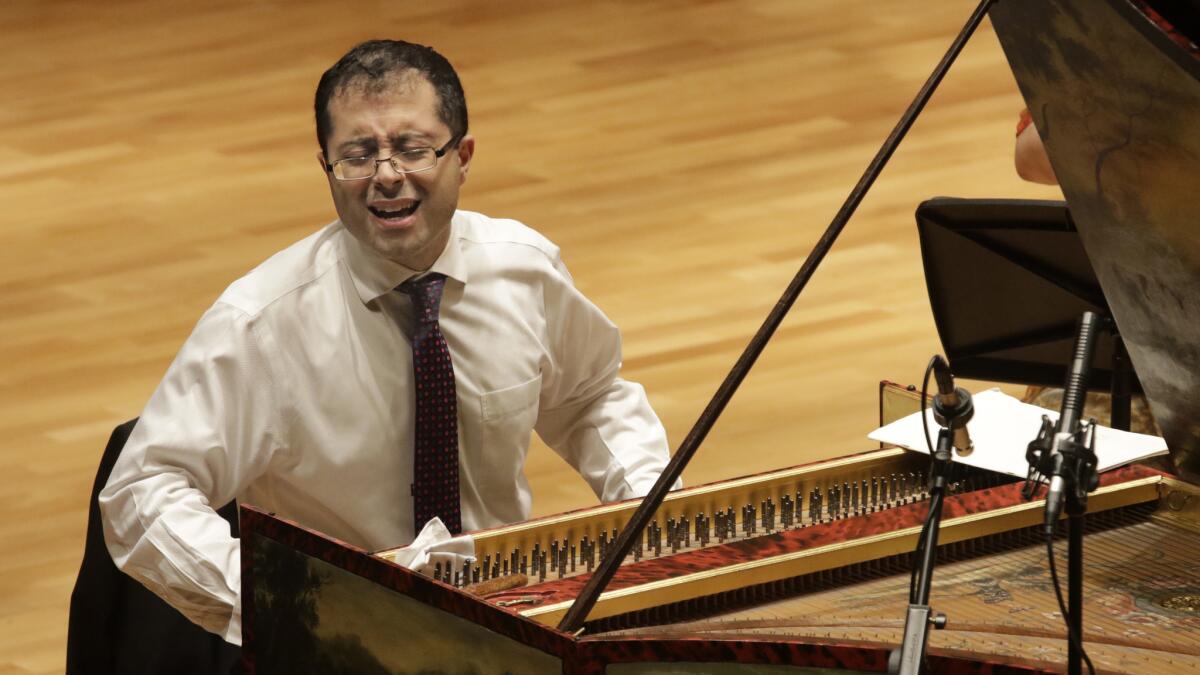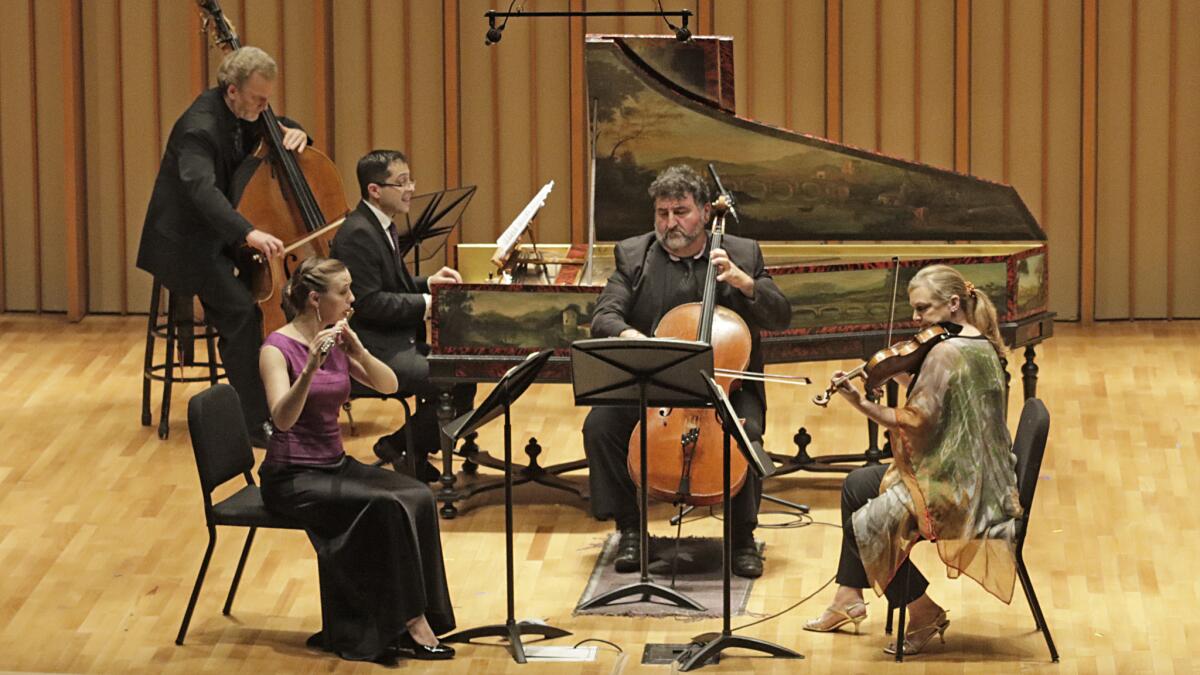Review: Hip harpsichordist Mahan Esfahani goes for Baroque but is unfortunately hard to hear

Mahan Esfahani, harpsichordist performs JS Bach’s Harpsichord Concerto #1 with members of the Los Angeles Chamber Orchestra in the Baroque Conversations series.
- Share via
Someday, perhaps, a lively musicologist will examine the history of the harpsichord and hipness. The antique plucked keyboard helped define music in the Baroque era and, through its tuning, the future of the Western art form.
But once the piano took over in the 19th century, old harpsichords were refashioned into desks and other pieces of furniture. The Baroque revival in the ‘60s renewed interest in the instrument, and metallic harpsichords even began showing up on Beatles and Rolling Stones songs.
SIGN UP for the free Essential Arts & Culture newsletter >>
Mahan Esfahani, who was the guest host for Los Angeles Chamber Orchestra’s Baroque Conversations program Thursday night, is a hip harpsichordist for a new generation. He recently became the first harpsichord in decades to be signed by Deutsche Grammophon. He is a stylish dresser and a raconteur with a mischievous sense of humor and a penchant for colorfully offbeat music, be it Baroque or modern.

Harpsichordist Mahan Esfahani with members of the Los Angeles Chamber Orchestra perform Telemann’s Paris Quartet #7 in the Baroque Conversations series.
The captivating new Esfahani recording, “Time Present and Time Past,” alternates Baroque pieces with contemporary ones, including Esfahani’s harpsichord reimaging of Steve Reich’s “Piano Phase.” Turn that Reich track up loud, to the levels that Anne Teresa De Keersmaeker did when she danced to a recording of the original Tuesday night at Royce Hall, and the hypnotic early Minimalist score becomes so electrifying that it is the piano that seems a dowdy old instrument in comparison.
Esfahani’s rhythmically revealing solo playing of Bach’s Harpsichord Concerto in D Minor, which follows, seems intent on exuberantly exposing Bach as an ultra-hip distant ancestor of Reich.
Leading a handful of LACO players from the keyboard in the Colburn School’s Zipper Concert Hall, Esfahani ended his program with that same Bach concerto. He went to town brilliantly. But by that point in the evening I could see the attraction of removing the keyboard and guts from the colorfully painted harpsichord on stage and using what was left as the base for a retro-hip hutch.
This may be the time to bring up harpsichord hatred. Esfahani was introduced Thursday as having said he took up the harpsichord as an act of teenage rebellion. British conductor Thomas Beecham once likened the harpsichord’s sonic quality to that of two skeletons copulating on a roof in a thunderstorm.
Personally, I would have been very happy for that sound — or any sound! — from my seat at Zipper, a mere seven rows from the stage in an intimate hall.
The fact is for nearly the entire evening, the harpsichord remained inaudible. It simply cannot work in a modern concert hall without amplification, especially when played against potent modern instruments. Nor did Esfahani put together with LACO the kind of interesting program he does on his recordings.
The first three of the four works were, harpsichord-wise, modest. The evening began with the workably bland Ouvertüre IV by the forgotten Philipp Heinrich Erlebach. Allan Vogel was the appealing oboe soloist for Bach’s Sonata in G Minor, BWV 1020, but he seemed constrained by having to hold back to something comparable to the tiny volume coming from the keyboard. Cellist Armen Ksajikian doubled the harpsichordist otherwise inaudible left hand bass part, but still Esfahani’s crucial right-hand melodic counterpoint seemed as if coming from his dressing room backstage.
Same thing with Telemann’s amiable Paris Quartet No. 7. There were five players for this quartet, this time bassist Peter Lloyd boomingly doubling Esfahani’s left hand. The others that could be heard — flutist Sandy Hughes, violinist Margaret Batjer and Ksajikian — were a lovely trio. The harpsichord, on the other hand, added not more than the faintest glittery tinkle.
For the Bach concerto, a loudspeaker was placed in front of the stage. It did no good — either the amplification was immeasurably discreet or not turned on. Esfahani worked up a sweat, but there is simply nothing to be said about the performance.
Esfahani did address the quietude of harpsichord music in answer to a question from the audience afterward, noting that it is an instrument for quieter times. But in a era of bombarded ears, the harpsichord’s beauty, range of timbre and texture, and, yes, hipness can only be appreciated close-up. Has anyone thought of turning harpsichords into loudspeaker cabinets?
ALSO:
Classical music + visuals = intrigue, at UCLA’s ‘Beyond Music’
‘Fase’ a mesmerizing Minimalism map to Steve Reich’s music
Seattle conductor Ludovic Morlot at the helm of the L.A. Phil for ‘Become Ocean’
More to Read
The biggest entertainment stories
Get our big stories about Hollywood, film, television, music, arts, culture and more right in your inbox as soon as they publish.
You may occasionally receive promotional content from the Los Angeles Times.











